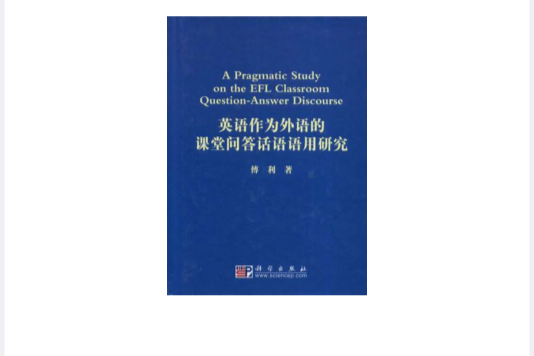內容簡介
《英語作為外語的課堂問答話語語用研究》在運用話語分析的相關理論對課堂問答話語進行靜態研究的同時,重點運用語用學的主要理論,諸如言語行為、語用前提、合作原則、禮貌原則等,對英語作為外語的課堂問答話語進行了動態研究。
英語課堂教學需要很多語言交流活動,即課堂言語互動。課堂教學的言語互動主要體現在師生言語互動上,而這種言語互動叉往往通過問與答的形式來完成。
語用學研究的是特定語境中的特定話語。在外語課堂教學這一具體語境中,教師的話語角色與他們的社會角色既相一致又相矛盾,這種矛盾統一在問答話語中得到充分的體現。一方面教師通過提問、反饋控制課堂話語和話輪;另一方面教師採用很多禮貌言語策略,鼓勵學生參與課堂互動。在對課堂問答話語的理解與闡述上,英語作為外語的教學語境起著至關重要的作用。言語行為理論為課堂問答話語實施不同功能提供了理論依據。提問可以使言成功有所為,即通過說出(言內行為)“提問”(次要言外行為)這一言語,間接發出指令(主要言外行為),使聽話人按照指令行事(提問的言後行為);“回答”(言內行為),如解釋、造句、朗讀等(言外行為),同樣是按照提問的間接指令在以言行事,滿足提問不同的語用前提,達到提問以言致效的結果。在課堂回答話語中,師生均有違背合作原則的言語。教師違反數量準則,提供比問題所要求更詳盡的話語是在利用回答增加言語輸入;學生對數量準則、質量準則、關聯準則或方式準則的違反,源於語言知識或技能的欠缺。在禮貌原則方面,師生也有許多與社會角色相脫離、與禮貌原則相悖的言語現象。這種對禮貌原則的違反,在課堂教學語境下有助於完成教學任務。
在討論了課堂提問的八種形式、五種功能和回答的三種類型後,我們認為受課堂語境制約,學生作出的非期待回答、零回答與期待回答一樣都對教學具有反饋意義。
書籍目錄
序
Acknowledgements
Abstract
內容提要
Chapter 1 Introduction
1.1 Objectives of the Study
1.2 Rationale for the Study
1.3 Methodology and Data for the Study
1.3.1 Methodology
1.3.2 Data collection
1.3.3 Data description
1.3.4 Limitations in data collection
1.4 Outline of the Book
Chapter 2 Review of Discourse Analysis
2.1 Discourse Analysis
2.1.1 Early attempts
2.1.2 Sociological approach
2.1.3 Sociolinguistic approach
2.2 Critical Discourse Analysis
2.2.1 Discourse as power/knowledge
2.2.2 Discourse as social practice
2.2.3 Discourse as(re)production of dominance
2.2.4 Critique
2.3 Classroom Discourse Analysis
213.1Hierarchical rank model
2.3.2 Instructional phase
2.3.3 Language classroom research
2.3.4 Critical analysis of classroom discourse
2.3.5 Classroom question and answer research
Summary
Chapter 3 Pragmatic Theories for the Study
3.1Context
3.1.1 What is context?
3.1.2 The context-bound study
3.1.3 The context-bound discourse
3.2 Speech Act Theory
3.2.1 Speech acts
3.2 2 Illocutionary acts
3.2.3 Questions and answers as illocutionary acts
3.2.4 Questions as indirect directives
3.2.5 Questions and answers as indirect speech acts
3.3 Interpersonal Rhetoric
3.3.1 Cooperative principle(CP)
3.3.2 Politeness principle(PP)
3.3.3 Questions as face-threatening acts?
3.3.4 Answers and silence as face-losing acts?
Sumary
Chapter 4 Questions in the EFL Classroom
4.1 Forms of Questions
4.1.1 General questions
4.1.2 Special questions
4.1.3 Alternative questions
4.1.4 Disjunctive questions
4.1.5 Rhetorical questions69
4.1.6 Declarative and imperative questions‘70
4.1.7 Shortened forms of questions72
4.2 Functions of Questions74
4.2.1 Informative function
4.2.2 Interpersonal function
4.2.3 Directive function
4.2.4 Instructive function
4.2.5 Exploratory function
4.3 Features of Teacher’s Questions
4.3.1 Reiteration of questions
4.3.2 Simplification of questions
4.3.3 Clustering of questions
4.3.4 Self-answering of questions
Summary
Chapter 5 Answers in the EFL Classroom
5.1 Criteria for the Classification of Answers
5.1.1 Adjacency pair
5.1.2 Pragmatic presupposition
5.1.3 Cooperative principle
5.2 Preferred Second Pair Part
5.2.1 Adequate answers
5.2.2 Excessive answers
5.3 Dispreferred Second Pair Part
5.3.1 Deficient answers
5.3.2 Incorrect answers
5.3.3 Indirect answers
5.4 Zero Second Pajr Part
5.4.1 Silence and void of action
5.4.2 Examination of silence
Summary
Chapter 6 Question——Answer Structures in the EFL Classroom118
6.1 Instructional Interaction
6.1.1 Institutional talk and ordinary talk
6.1.2 Institutional interaction and classroom interaction120
6.1.3 Teacher’S domination of tum·taking·122
6.2 Question·Answer Structures123
6.2.1 Initiation-Response124
6.2.2 Initiation-Response-Feedback125
6.2.3 Initiation-Responselflnitiation2一Feedback/Response2
6.2.4 Initiation-Response-Feedbackfl2一(Ra·F2f13)
6.2.5 Initiation-Response(一h-R2)一Feedback
6.2.6 Initiation-Response-Feedback一(R2Fn)
6.3 Examination of Question-Answer Structures
6.3.1 The IRF structure133
6.3.2 Examination of the initiation
6.3.3 Examination of the response
6.3.4 Examination of the feedback
6.3.5 Extension of the IRF structure
6.4 Repairs in the Question-Answer Discourse
6.4.1 Intra-sentence repairs
6.4.2 Intra-tum repairs
6.4.3 Inter-rum self-initiated other-repairs
6.4.4 Inter-tum other-initiated other-repairs
6.4.5 Tri-tum repairs
6.4.6 Examination of the repairs
Summary
Chapter 7 Conclusion
7.1 Limitations in the Study
7.2 Summary of the Study
7.3 Implications for EFL Teaching
7.3.1 The role relationship between teacher and student
7.3.2 The increase of student talk
7.3.3 The functions of feedback
7.3.4 The development of students’pragmatic competence
7.4 Suggestions for Future Research
Bibliography
Appendices
Appendix 1 Transcription Conventions
Appendix 2 Transcripts of Chapter 5
Appendix 3 Transcripts of Chapter 6

